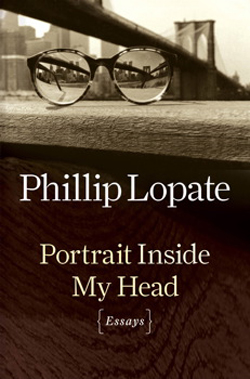Portrait Inside My Head: Essays
by Phillip Lopate
reviewed by Jericho Parms
“Reader, you have in your hand a motley collection of essays,” Phillip Lopate writes in the opening pages of Portrait Inside My Head, the latest title from the author of over a dozen books, including four previous essay collections and the landmark anthology The Art of the Personal Essay, the forward to which still serves as one of the best introductions to the form. Phillip Lopate just may be the contemporary godfather of the personal essay, the scope and depth of his inner musings like those of a modern-day Montaigne.
The opening of Lopate’s latest collection is a defense of the miscellaneous collection. In Portrait Inside My Head, his subjects range from the Black Panthers to Major League Baseball, from “Changing One’s Mind about a Movie” to the “Laws of Attraction” (which has something to do with lipstick and women’s jeans), from sex and empathy to poetry and Brooklyn.</ p>
While the essay as a genre often falls short of sustained narrative and scene—attributes more characteristic of fiction, which keeps readers, well, reading—it relies more than anything on voice, keen observation, and intimacy. Lopate’s loyalties are to sundry intellectualism and the commonplace observations that inhabit a single roving mind at work and at play.
The book is loosely organized in sections—The Family Romance, The Consolations of Daily Life, City Spaces, Literary Matters. In “The Countess’s Tutor,” Lopate recalls the Brooklyn streets where he and his brother were bullied; but the next page takes a nuanced turn to reveal the author himself in the role of devilish tormentor. Lopate’s admirers will recognize his self-interrogating wit and the sharp insight he brings to seemingly common observations: the recognition that “Something is wrong when the slum dwellings of our youth have become the prewar desiderata of the next generation,” or how the near-slapstick memory of a lost balloon in the Plaza’s Palm Court shows “that emotions do not have to be reasonable to shatter us” and that “sobs feed uncontrollably on sobs.”
Those new to Lopate’s work will likely emerge with a newfound admiration for the subtle art of association: the way the essayist manages to juxtapose the late George Steinbrenner against the legacy of Montaigne or envisions a Japanese samurai as a means of understanding the Mets baseball club.
“Part of becoming a grown-up is accepting one’s limitations,” Lopate writes in “Why I Remain a Baseball Fan.” And if there is an overarching theme in this particular collection, it is the recognition of limitations, which tugs like an undercurrent toward the notion that our imperfections can lead to self-knowledge. Lopate considers his inadequacy as an athlete and his struggle with empathy as he examines literature, film, his relationship to his beloved brother (which is not without strands of rivalry), and, of course, Brooklyn, whose brownstones and low-rise streetscapes run through many of the essays in this book.
Over the course of his career, Lopate has set out to champion the essay as a conduit of human expression and companion to the mind at work. Portrait Inside My Head, a work of both charm and intellect, shows him to be a master of the form.
Published on February 1, 2014

